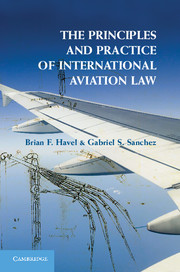Book contents
- Frontmatter
- Contents
- Preface
- Acknowledgments
- Table of Abbreviations and Acronyms
- 1 What is International Aviation Law?
- 2 The Foundations of Public International Aviation Law
- 3 The International Law Regime for Trade in Air Services
- 4 The International Law Regime for Airline Investment and Global Alliances
- 5 The International Law Regime for Aviation Safety and Security
- 6 The International Law Regime for Aviation and the Environment
- 7 The International Law Regime for Air Carrier Liability and Surface Damage
- 8 The International Law Regime for Aircraft Financing and Aircraft Nationality
- Afterword
- Select Bibliography
- Table of Authorities
- Index
Afterword
Published online by Cambridge University Press: 05 June 2014
- Frontmatter
- Contents
- Preface
- Acknowledgments
- Table of Abbreviations and Acronyms
- 1 What is International Aviation Law?
- 2 The Foundations of Public International Aviation Law
- 3 The International Law Regime for Trade in Air Services
- 4 The International Law Regime for Airline Investment and Global Alliances
- 5 The International Law Regime for Aviation Safety and Security
- 6 The International Law Regime for Aviation and the Environment
- 7 The International Law Regime for Air Carrier Liability and Surface Damage
- 8 The International Law Regime for Aircraft Financing and Aircraft Nationality
- Afterword
- Select Bibliography
- Table of Authorities
- Index
Summary
The European Union (EU) created a framework for aviation liberalization within its single market jurisdiction and has embarked on the task of establishing “horizontal agreements” (and a few comprehensive agreements) with the rest of the world. The EU is slowly but surely harmonizing more than 3600 bilateral agreements that exist between all the Member States and their aviation counterparts across the world. We could perhaps debate whether, particularly in the context of the U.S./EU open skies agreement, the EU used its leverage effectively. With respect to other third countries, the EU is frequently challenged to demonstrate the added value it creates vis-a`-vis traditional bilateralism – to which the European Commission consistently replies that, in a global context, the Member States systemically diluted and fragmented Europe’s negotiating clout.
The United States has likewise sought to export its version of open skies. Although at times criticized for having opened international aviation markets, but not the equally large continental U.S. market, for international competition, the United States is the uncontested leader in the liberalization of traditional closely regulated bilateral aviation markets.
- Type
- Chapter
- Information
- The Principles and Practice of International Aviation Law , pp. 393 - 398Publisher: Cambridge University PressPrint publication year: 2014



